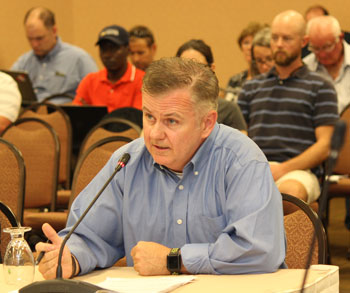River Herring/Shad Action Shot Down
by Laurie Schreiber

Roger Fleming, Earthjustice. “Bycatch caps have been in place for a while. They’re not science-based. They’re just based on recent catch. They’ve done nothing to help these stocks rebound.” Fishermen’s Voice photo
PORTLAND—The New England Fishery Management Council (NEFMC) voted to take no action on a proposal to include river herring and shad as stocks in the herring management plan. The decision came after discussions, dating back to 2015, about whether NEFMC should begin managing river herring and shad in federal waters through the plan.
Roger Fleming, an attorney with the environmental law organization Earthjustice, urged NEFMC to take action. “The key legal question here is, do river herring and shad require conservation and management?” he said. “There’s ample evidence that shows river herring and shad do require conservation and management. Bycatch caps have been in place for a while. They’re not science-based. They’re just based on recent catch. They’ve done nothing to help these stocks rebound. The development of a fishery management plan would require the developoment of science-based reference points and a rebuilding plan.” He continued, “The fact is these stocks are severely overfished and have been for years. They’re at historically low levels.”
“There’s ample evidence
that shows river herring
and shad do require
conservation and
management.”
– Roger Fleming, Earthjustice
According to the NEFMC news release, NEFMC based its decision on the following:
• River herring and shad already are adequately managed through a coastwide collaborative process led by the Atlantic States Marine Fisheries Commission (ASMFC) and the National Marine Fisheries Service, with NEFMC and the Mid-Atlantic Fishery Management Council (MAFMC) as partners. Both NEFMC and MAFMC use catch caps to control incidental takes of river herring and shad in the Atlantic herring and mackerel fisheries respectively in federal waters. Development of a federal plan likely would not improve river herring/shad stock condition.
• No directed fishery takes place in federal waters for river herring and shad, and directed fishing for Atlantic herring or mackerel is prohibited once a NEFMC-imposed river herring/shad catch cap is reached. The vast majority of the river herring/shad harvest takes place in state waters via in-river harvest, and only on stocks that can be harvested at sustainable levels through ASMFC-approved Sustainable Management Plans. All other areas are closed to harvest.
• States operate under habitat programs that identify river herring and shad habitat at all life stages – spawning, egg, and juvenile – and include steps to restore access to riverine habitat.
• Essential Fish Habitat (EFH) designations already exist for other species in federal plans, such as Atlantic salmon, that overlap with offshore areas where river herring and shad occur. In addition, some federal EFH designations also cover species that prey on river herring and shad. Therefore, an EFH designation through a federal plan would not notably improve what already is in place.
